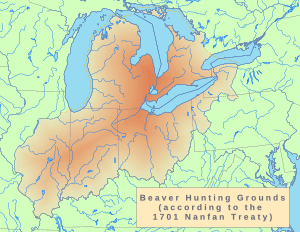Nanfan Treaty facts for kids
| Deed from the Five Nations to the King, of their Beaver Hunting Ground | |
|---|---|

Map showing the approximate range of the "Beaver Hunting Grounds" described in the Nanfan Treaty.
|
|
| Signed | July 19, 1701 |
| Location | Albany, New York |
| Amendment | September 14, 1726 |
| Parties |
|
The Nanfan Treaty was an important agreement signed on July 19, 1701. It was made between the Iroquois Confederacy (also known as the Five Nations) and John Nanfan. John Nanfan was the temporary governor of New York, representing the King of England (called The Crown). The treaty was signed in Albany, New York. Later, on September 14, 1726, both sides made some changes to the agreement.
Contents
What Was the Nanfan Treaty?
This treaty is also known as the "Deed from the Five Nations to the King, of their Beaver Hunting Ground." It was a document where the Iroquois Confederacy gave a huge area of land to the King of England. The Iroquois had claimed this land as their hunting grounds.
The Land Given Away
The land covered a very large area. It included big parts of what is now the Midwestern United States. It also included southern Ontario in Canada. The Iroquois claimed this land because they had won it in battles. These battles were part of the Beaver Wars in the 1600s. The land stretched as far west as a place called 'Quadoge', which is now Chicago.
The Five Nations, who later became the Six Nations after 1720, decided to give this land. They did this because they felt thankful for the kindness shown to them by King William III of England.
French Disagreement
Most of the land described in the Nanfan Treaty was also claimed by New France. New France was the area controlled by the French in North America. Many Algonquian Native American groups, who were allies of the French, also claimed parts of this land. Because of this, the French did not agree with the Nanfan Treaty.
However, in 1713, the Treaty of Utrecht was signed. In this treaty, France did agree that the Iroquois were under the protection of the British King. For a while, the English did not try to settle these lands.
Treaty Changes in 1726
About 25 years after the first treaty, changes were made. This happened on September 14, 1726. A strip of land was set aside for the Six Nations. This strip was 60 miles wide. It was next to Lake Erie and Lake Ontario. It started near Sandusky Creek.
The Six Nations were allowed to continue living on and using this land. This was with the permission of the King of Great Britain, who was the owner of the land according to the 1701 agreement.
Where to Find the Treaty
A copy of the Nanfan Treaty still exists today. It includes special drawings called totem images. These totems belong to more than a dozen Iroquois chiefs. This important document is kept in the collections of the British National Archives.

